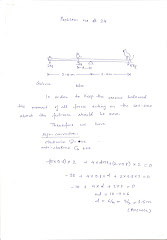Hello, once again continuing with my mission to provide online reference for solving practical physics problem, today i would like to take up the discussion of vectors.
The concept of vectors is instrumental in solving problems of maths, physics and engineering. Therefore it is more than just important to understand the underlying concept of vectors before trying to solve confidently the problems of the above mentioned areas.
We can define a vector, simply as a physical quantity that has magnitude as well as direction. Examples of vector quantities are Displacement, Velocity, Force, Acceleration etc. Another way of defining a vector can be, the quantities that follow the vector law of addition.
Laws of vector addition:
There are 2 laws of vector addition.
1) Triangle Law of vector addition: "It states that if 2 vectors AB and AC represent two sides of the triangle in order, then the sum of the two vectors is given by the third closing side BC of the triangle in reverse order."
2) Parallelogram law of vector addition: "It states that if the two vectors OA and OB represent the two sides of a parallelogram then the resultant of these two vector is given by the diagonal OC."
Subscribe to:
Post Comments (Atom)





No comments:
Post a Comment